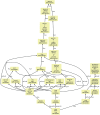The Ontology Lookup Service: bigger and better
- PMID: 20460452
- PMCID: PMC2896109
- DOI: 10.1093/nar/gkq331
The Ontology Lookup Service: bigger and better
Abstract
The Ontology Lookup Service (OLS; http://www.ebi.ac.uk/ols) has been providing several means to query, browse and navigate biomedical ontologies and controlled vocabularies since it first went into production 4 years ago, and usage statistics indicate that it has become a heavily accessed service with millions of hits monthly. The volume of data available for querying has increased 7-fold since its inception. OLS functionality has been integrated into several high-usage databases and data entry tools. Improvements in the data model and loaders, as well as interface enhancements have made the OLS easier to use and capture more annotations from the source data. In addition, newly released software packages now provide easy means to fully integrate OLS functionality in external applications.
Figures




References
-
- Rubin DL, Shah NH, Noy NF. Biomedical ontologies: a functional perspective. Brief. Bioinformatics. 2007;9:75–90. - PubMed

